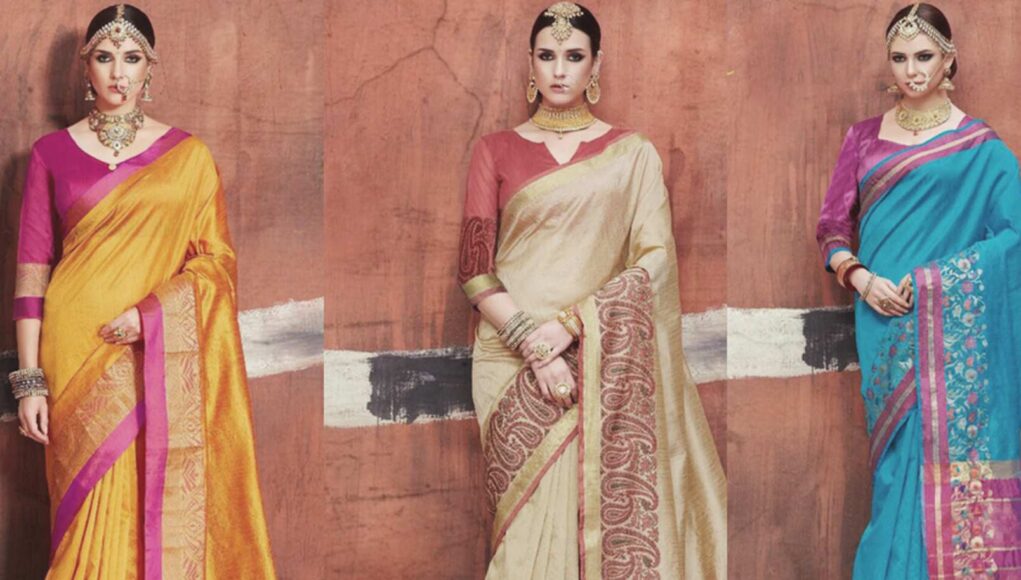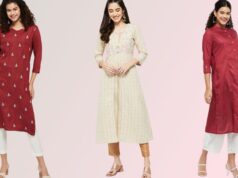Last Updated on 7 years by Naveen Kumar
Sarees are truly stories woven in silk! This traditional Indian attire, a manifestation of elegance, can make any woman look sensuous and graceful at the same time.
Most often, we all have a story related to the sarees in our wardrobe, be it our mother’s, grandmother’s or friends; hence, they are more of an emotional keep, connecting our memories together in silk threads! As is the case for most women, you probably never bought the first saree that you wore, rather you chose it from your mother’s wardrobe!
And when you talk about sarees, the topic is never complete without the mention of the most favorite kind, the ultimate, Silk sarees!
They are a lot more than just six yards of cloth; it is the essence of our culture and tradition. From your grandmother’s wooden cupboard to a modern woman’s wardrobe, you will always find a treasured silk saree!. And what’s more, you can never go wrong wearing one.
Right from a simple silk saree to designer labels like the Sabyasachi, women have had a long relationship with silk sarees and is even part of most bridal trousseau.
So when we love silk sarees so much, it is also essential to know that most states in India have their own range of specialty silk sarees.
Among the myriad and innumerable kinds of traditional silk sarees in India, it can be difficult to choose one for yourself. So to simplify that, we give you an easy silk saree guide, featuring the most prominent and famous silk sarees that are a must have in a woman’s wardrobe!
Kanchipuram Silk Saree
The pride of South India and Tamil Nadu, these sarees are one of a kind and distinctively beautiful. These luxurious and lustrous silk drapes come in vivid and vibrant colours, and have graciously and elaborately designed contrast borders. Checks, florals and temple designs are some of the most commonly found motifs on the borders of Kanjeevaram or Kanchipuram sarees.
The premium quality, the unique and intricate designs and their directly proportional cost makes them a favorite and famous choice even by celebrities, who do not shy away from any opportunity to adorn them.
Kanchipuram sarees derived its name from the village in which they were weaved; these sarees are hand-woven with dyed silk yarn taken from pure mulberry silk, with interleaved designs made with zari (made of gold or silver); the silk thread is twisted with silver and then gilded with gold!
Loved by all, these sarees are considered even as heirloom items (they are highly durable and expensive), and are most South Indian brides’ pride and dream!



Banarasi Silk Saree
Coming from the banks of the Ganges, the city of Varanasi, these sarees have a lot of stories to tell- of the lives and hardships of the weavers in creating that perfect piece of Banarasi silk saree, that can easily take anywhere from 15 days to an year! Such is the story of silk!
Quite recently, Banarasi sarees have been on the fashion radar, especially after the wedding reception photos of Anushka Sharma in a gorgeous red Banarasi saree became viral!
Initially made for the royalty, these are one of the finest kinds of silk and the Mughals had a huge role in boosting the Banarasi silk weaving industry. These sarees are intricately and lavishly designed with brocades, zari motifs and other Mughal inspired designs all around. You would also come across sarees with motifs like a string of leaves known as Jhallar. The compact weaving and the intricate work adds to the price of these sarees and they are quite on the premium end.
Just like the Kanchipuram silk sarees, these are also a part of most brides’ trousseau and is considered a must have in every saree loving woman’s wardrobe.



Mysore Silk Saree
Another famous and fine silk originating from the South, Karnataka, is the Mysore Silk. Mysore is known for its royal heritage and hence it is no surprise that the silk coming from Mysore reflects the splendor and tradition of Mysore, with most of the motifs on the saree being a tribute to the ancestry of Mysore. These sarees are quite rich and have a traditional appeal. Its a favored choice for women who are not fans of heavy designs and prefers soft and light silk sarees.
The most distinct feature of the saree is the use of genuine silk and pure gold zari that radiates a natural sheen and rich texture. Since these sarees are exclusively manufactured and produced, each piece has a distinct mark, guarantees authenticity and long-lasting fabric.
These vibrant yet subtly designed sarees with a smooth texture and rich feel makes it an eternal favourite for weddings and traditional ceremonies.
Tip: Ideally, when buying a Mysore Silk saree, look for the KSIC hologram to ensure the authenticity.
Tussar Silk Saree
A favorite even among the modern women, these affordably priced range of silk sarees, are said to have originated from the regions of West Bengal, Bihar and Jharkhand. Tussar silk is also called Kosa silk, and the specialty of this silk is that it is produced from the silkworms that are found on wild forest trees rather than mulberry trees. The weaving of Tussar Silk is done by Indian tribal women who are trained in the art of its production.
Naturally textured, these luxurious and light silk sarees are available in rich vibrant shades with contrast borders and geometric patterns or stripes.


Bhagalpuri Silk Saree
If you think silk sarees typically feature heavy designs and are suitable only for functions and weddings, Bhagalpuri silk sarees will change that for you.
These elegant sarees have today undergone a modern transformation and is fit to be worn to parties, office celebrations and even professional events and weddings.
Even Indian designers like Masaba Gupta and Nikhil Thampi has chosen these fabrics to experiment with contemporary designs.
Tip: Half and half Bhagalpuri sarees are a great trend now.
Raw Silk Saree
Raw silk is nothing but silk which has not been degummed (the gum like substance present in silk called sericin is not removed). Hence this is slightly textured than the pure silk and much more cheaper. Since it is the degumming process that lends silk the luster and shine, raw silk lacks those features.
Raw silk sarees are a great option for simple and casual events, not necessarily and limited to weddings and special occasions.


Jute Silk Saree
Jute is an environmental friendly and natural fibre which is smoothened and softened and then combined with silk, to create jute silk sarees. With a polished and luxurious texture, jute silk sarees are now widely popular among women and are available in rich vibrant colors.These light fabric sarees are a bit duller than the pure silk sarees owing to the distortion of the jute fibres.
Jute silk sarees are in the affordable range and are perfect for office, simple occasions and for casual days as well.
Konrad Silk Saree
Also called as ‘Temple Saree’ since they were initially woven for temple deities, they originated in Tamil Nadu.
These premium and expensive sarees have beautifully designed wide borders and features motifs of natural elements and animals with a royal touch. Most common designs include floral motifs like flowers, vines, creepers, and also animals and birds such as peacocks, elephants, parrots, double headed eagles among the others. Another distinguishing feature which sets a traditional Konrad saree apart from other silk sarees, is the fact that it has a distinctive appearance and feel to it, which does not look or feel like silk, although it is very much a silk saree.
These sarees are quite widely used in weddings and other similar special occasions.

Paithani Silk Saree
Hand woven in very fine silk, Paithani sarees that originated in Maharashtra region, is considered as one of the richest saris in India. Typically, these sarees feature borders of an oblique square design and a pallu with a peacock design. The most interesting feature of a Paithani handloom saree is that both sides of the saree look exactly the same, both the border and the the pallu. In fact, that is a tell tale sign of the original Paithani handloom.
Another key feature of this saree that forms an integral part of a Maharashtrian bride’s trousseau is that it doesn’t lose its lustre and unlike other silks, doesn’t wear out at the folds.


Chanderi Silk Saree
Originated in Chanderi, Madhya Pradesh, these sarees are known for their sheer texture and light weight and is produced of three kinds of fabrics, namely, pure silk, chanderi cotton and silk cotton.
A favorite among women of all ages, these sarees have a charm that can enchant anyone and have different types of motifs in gold and silver woven into them. The most common patterns found on these traditional silk sarees are coin, flora art, peacocks and also geometric designs.
These low cost sarees are ideal for simple functions, get-togethers, religious or ethnic events, and the best part is that they are great for summers!


Cotton Silk Saree
Cotton silk fabric is a blend of both fibers, combining positive characteristics of each into a single textile. A lightweight, silky and comfortable weave, silk cotton fabric has a soft hand-feel and a sturdy, silken drape.
It is an excellent substitute for pure silk and will not burn a hole in your pocket.
Available in so many vibrant and rich shades, they are very common with contrast borders.
Kota Silk Saree
Also called Kota Doria, the distinct looking fabric, with its brilliant square pattern, is every saree lover’s delight. The supremely airy and lightweight fabric is very comfortable to be worn in summers and demands less maintenance, making it quite a favorite among women. Though Kota fabric is slightly coarse and sturdy, the Kota silk is a much smoother, shinier and softer version.
Though the weave originated in Mysore, these affordable range of sarees were manufactured in Kota, Rajasthan, and hence called Kota silk sarees.
Light as air, they are ideal for casual use, college or office functions get-togethers.


Art Silk Saree
Artificial silk or Art Silk is a type of low cost synthetic fabric that resembles silk. It is a very light and soft fabric that is quite lustrous and apt for the warm Indian climate. This fabric is usually made out of rayon or bamboo viscose (hence also called Bamboo silk).
As expected, these sarees are much less expensive and are ideal for casual use, college functions, simple celebrations, religious events
Organza Silk Saree
Organza silk saree is a thin, plain weave, sheer fabric saree, made from silk. The plain weave makes the fabric strong and durable. The organza woven in India is slightly coarser, making it perfect for making sarees.
These sarees are thinner and lightweight than other sarees and feature traditional and contemporary design motifs .
These fine quality sarees are on the expensive side and are perfect for semi-formal and casual occasions.


How to identify original silk? What is the difference between authentic and fake silk?
Kanchipuram, Banarasi are some of the most premium and superior quality of silks available and we even pay a hefty amount to get our hands on some of these fine quality sarees. But are they really what they claim to be?! Ho do you know you have not been tricked into buying a fake one?
So here are a couple of tips to keep in mind when buying a premium quality silk saree.
- You need understand and accept that fine quality silk does not come at a cheap price. So if someone is trying to sell you a Banarasi or Kanchipuram saree for Rs.6000, then you need to realise that cannot be original. Hence remember that price is a key indicator.
- Preferably select reputable stores to buy premium quality sarees.
- Most fine quality silk, for example, Mysore Silk or Kanchipuram Silk, comes with a KSIC hologram or a Silk Mark, respectively. Hence, do not forget to check for these marks and labels.
- Though not recommended, you can also do the burn test. Burn a few threads of the silk, and if you there is a smell similar to that of burning hair, then, Voila!, you appear to have burnt some genuine silk.
- Zari test is another way to check the ingenuity. Pure zari is made of red silk thread that is twisted with a silver thread and then dipped in pure gold. When you pull the zari and find that the silk thread is not red but white or any other colour, then you can be sure that the silk is not genuine, especially in the case of Kanchipuram sarees.
- Also, there are other key factors like the smoothness, lustre, the weaving and the pattern.
Do you think there are more Silk sarees that are highly prominent? Then do let us know through your comments.




















These silk sarees are really pretty. In love with the last one. Looks very elegant and the colour is also unique for silk sarees.
paithani silk saree